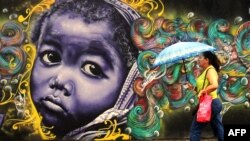Football's (soccer's) World Cup will end this Sunday in Brazil, a nation with the world's largest black population outside of Africa. Although many Brazilians think of their country as the model of race relations, racism is a hidden reality.
On the country's Atlantic shore, the tropical city of Salvador de Bahia faces the African coastline far beyond the horizon. It's a city symbolic for Brazil's African roots.
Slavery was abolished in Brazil in 1888 and here, more than anywhere else, the links with Africa are evident. In Salvador, African descendants represent more than 80 percent of the population. In Brazil, more than 50 percent of the population is of "metis," or mixed-race - and social contact, friendships and marriage between the races are common.
However, on television or seen from abroad, Brazil still portrays a white image. Blacks, indigenous or other non-white people are seen less than whites on TV commercials and programs.
Racism is both everywhere and invisible, and has its effect on education, employment, income and life expectancy.
Celene Fonseca, an anthropologist, explains why racism is hidden in Brazil.
"You have the formal democracy in Brazil, but we are not part of it. Black, Indian, Metis people in general, we are not here," she said. "In Brazil, there is an apartheid who does not say its name. We are servants of the white people, even if we represent the overwhelming majority of the population."
Brazilian President Dilma Rousseff says she wanted to have a World Cup without racism; but, outside the stadiums, the reality is different for black people. Social worker Elaine Amazonas describes the daily humiliations.
"The restaurants... the stores you go to, the grocery stores when you go shopping, the security guy accompanying you," she said. "It's a daily thing."
Black teenagers are the first victims of the current situation. According to Suely Santos Souza from the Unified Black Movement, nine out of 10 children killed between the ages of 12 and 23 are black.
In education, the situation started changing when the Brazilian government enacted sweeping affirmative action laws two years ago to vastly increase the number of university students of African descent. Before this, only 1 percent of students at the university were black. Today, they represent 11 percent.
Suely Santos Souza works mostly to change to content of the programs at school.
"Nowadays in Brazil, it is mandatory to learn at school the history of African descendants and Indian people," she said. "It is one of the accomplishments of the Unified Black Movement."
Politicians are viewed as conservative and minorities face challenges to be elected to office or hold high government positions. The renowned musician Gilberto Gil, who is of African descent, was Brazil's culture minister between 2003 and 2008. Brazilian Supreme Court Justice Joaquim Barbosa, who is black, announced he would retire from the court and might run one day for office. But these examples are few.
The fight will be long and Salvador resident Anna Peskine, 67, is desperate to see changes. Peskine lives in both Brazil and France.
"Racism exists everywhere. In France, I accept it because I am a foreigner and black in the country of the whites," she said. "But here, at home, it is very difficult. In Brazil, I am not home."
Such comments make clear that Brazil still has a long way to go to achieve racial equality among its citizens.












